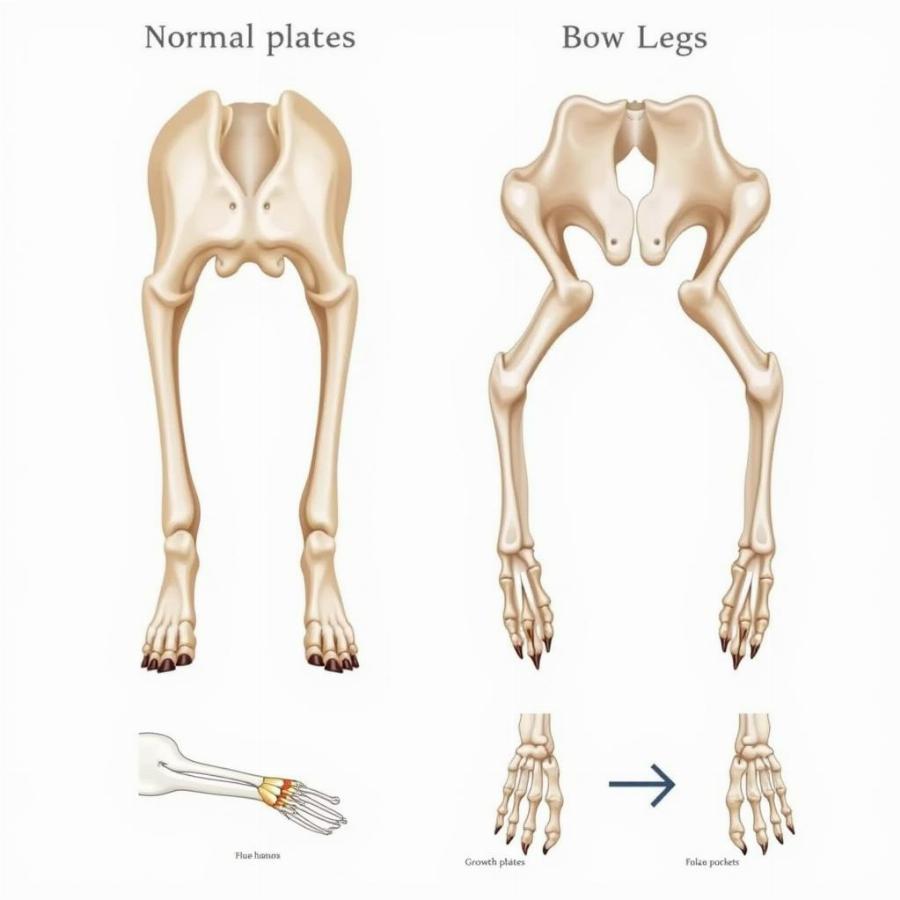Bow legs in dogs, medically known as genu varum, is a condition where a dog’s front legs curve outward, resembling a bow. While some breeds naturally exhibit a slight outward curve, excessive bowing can indicate an underlying health issue and potentially lead to discomfort or mobility problems. Understanding the causes, identifying the signs, and knowing when to seek veterinary care are crucial for responsible dog owners.
What Causes Bow Legs in Dogs?
Several factors can contribute to bow legs in dogs, ranging from genetic predispositions to nutritional deficiencies. Sometimes, it’s a normal part of a breed’s conformation, particularly in some dwarf breeds like Basset Hounds and Dachshunds. However, in other cases, it can signal a problem. One common cause is abnormal growth during puppyhood, often linked to nutritional imbalances, particularly a lack of calcium, phosphorus, or vitamin D. These deficiencies can lead to rickets, a condition that softens and weakens the bones, causing them to bend under the dog’s weight. Injuries to the growth plates, the areas of developing cartilage at the ends of long bones, can also result in bowed legs.
 Bow Legged Dog Causes
Bow Legged Dog Causes
Recognizing the Signs of Bow Legs
Is your dog bow legged? Sometimes it can be tricky to tell, especially in breeds with naturally curved legs. Look for an exaggerated outward curve of the front legs, where the paws point outward instead of straight ahead. You might also notice an awkward gait or a reluctance to exercise. Puppies experiencing rapid growth spurts are particularly susceptible, and their bowed legs might become more pronounced as they grow.
When Should You Worry About Bow Legs?
While mild bowing might not cause immediate concern, severe bowing can lead to pain, arthritis, and difficulty walking. If you notice your dog exhibiting any signs of discomfort, lameness, or an unusual gait, it’s essential to consult a veterinarian. They can diagnose the underlying cause and recommend appropriate treatment options. Early intervention is key to managing this condition and preventing long-term complications. Don’t hesitate to seek professional advice if you have any concerns about your dog’s leg conformation.
Treating and Managing Bow Legs in Dogs
Treatment for bow legs varies depending on the underlying cause and the severity of the condition. Nutritional deficiencies can often be addressed with dietary changes and supplements. Your vet might recommend a specific puppy food formulated to support healthy bone development. In some cases, bracing or splinting might be necessary to help straighten the legs, particularly in young puppies. Surgery is typically reserved for severe cases where the bowing causes significant pain or impairs the dog’s ability to walk normally.
Preventing Bow Legs in Puppies
Providing a balanced diet rich in essential nutrients is crucial for preventing bow legs in puppies. Choose a high-quality puppy food that meets the nutritional requirements for growing dogs. Avoid overfeeding, as excessive weight can put extra strain on developing bones. Regular veterinary checkups are also essential to monitor your puppy’s growth and development and identify any potential issues early on. You can find more information on puppy care at dogs for sale texas.
Conclusion
Bow legs in dogs can be a cosmetic concern or a sign of a more serious health issue. By understanding the causes, recognizing the signs, and seeking timely veterinary care, you can help your dog maintain healthy legs and a happy, active lifestyle. Remember, early intervention is key to managing this condition effectively. Looking for more information about dog health? Check out must love dogs grand haven.
FAQ:
- Is it normal for some dog breeds to have slightly bowed legs? Yes, some breeds, especially dwarf breeds, naturally have a slight outward curve to their front legs.
- Can bow legs in puppies correct themselves over time? Mild bowing might improve as the puppy grows, but more severe cases often require intervention.
- What are the long-term consequences of untreated bow legs? Untreated bow legs can lead to pain, arthritis, and mobility problems.
- How can I ensure my puppy gets the right nutrients for healthy bone development? Feed a high-quality puppy food and consult your vet about appropriate supplements.
- Is surgery always necessary for bow legs? Surgery is typically reserved for severe cases where other treatments have been unsuccessful.
- What should I do if I notice my dog’s legs are bowed? Consult a veterinarian for a proper diagnosis and treatment plan. You might also find helpful information regarding other breeds at mtg secret lair cats and dogs.
- How can I find reputable breeders who prioritize healthy bone development in their puppies? Research breeders carefully, ask about health testing, and consider adopting from shelters, such as shreveport pound dogs or rescues where health information is readily available.
Further Reading:
- Dog Breeds Prone to Leg Problems
- Understanding Canine Skeletal Development
- Nutritional Needs of Growing Puppies
- Choosing the Right Dog Food for Your Pet. More information on finding the right dog for you can be found at dogs for sale in philadelphia
Beaut Dogs is your trusted source for comprehensive information about dog breeds, care, and well-being. We provide expert advice and resources to help you navigate the joys and responsibilities of dog ownership. When you need assistance, please contact us at Email: [email protected] for detailed and accurate answers from Beaut Dogs. We’re committed to helping you provide the best possible care for your canine companion. Visit us at https://beautdogs.com today!